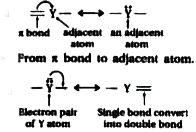Explain electron movement in organic reaction
Text Solution
The movement of electron in organic reactions can be shown by curved-arrow notation. It shows how changes in bonding occur due to electronic redistribution during the reaction. To show the change in position of a pair of electrons, curved arrow starts from the point from where an electron pair is shifted and it ends at a location to which the pair of electron may move. Presentation of shifting of electron pair is given below:

From π bond to adjacent bond positions.

From π bond to adjacent atom

From atom to adjacent bond positions.
Movement of single electron: Movement of single electron is indicated by a single barbed .fish hooks. (i.e. half headed curved arrow). For example:
(i) Transfer of electron in ethanol from hydroxide ion is as follow.

(ii) In dissociation of chloromethane, the movement of electron using curved arrows can be depicted as follows:

|
Topper's Solved these Questions
- ORGANIC CHEMISTRY SOME BASIC PRINCIPLES AND TECHNIQUESBOOK - KUMAR PRAKASHANCHAPTER - ORGANIC CHEMISTRY SOME BASIC PRINCIPLES AND TECHNIQUESEXERCISE - Section -A(Methods of Purification of Organic Compounds)
44 Videos
- ORGANIC CHEMISTRY SOME BASIC PRINCIPLES AND TECHNIQUESBOOK - KUMAR PRAKASHANCHAPTER - ORGANIC CHEMISTRY SOME BASIC PRINCIPLES AND TECHNIQUESEXERCISE - Section -A (Qualitative Analysis of organic compounds)
12 Videos
- ORGANIC CHEMISTRY SOME BASIC PRINCIPLES AND TECHNIQUESBOOK - KUMAR PRAKASHANCHAPTER - ORGANIC CHEMISTRY SOME BASIC PRINCIPLES AND TECHNIQUESEXERCISE - Section A (Fundamental Concepts in Organic Reaction Mechanism
10 Videos
- HYDROGENBOOK - KUMAR PRAKASHANCHAPTER - HYDROGENEXERCISE - Section-D NCERT Exemplar (Long Answer)
8 Videos
- QUESTION ASKED IN JEE -2018BOOK - KUMAR PRAKASHANCHAPTER - QUESTION ASKED IN JEE -2018EXERCISE - MCQ
10 Videos
Similar Questions
Knowledge Check
Which of the following statement is INCORRECT regarding electron movement in organic reactions ?
AThe curved arrow ends at a location to which the electron moves.BThe curved arrow begins from the point from where the electron is shiftedCThe movement of a single electron is shown by half - headed curved arrow.DThe atom to which an electron - pair from π−bond shifts will have a positive chargeCurved arrows are used in Organic Chemistry to show the movement of electrons in the mechanism of a reaction. The correct product of the following reaction is
 A
A B
B C
C D
D
Explain the movement in Indian plate.
View SolutionOrganic Chemistry: Some Basic Principles & Techniques - Electronic Effect|Electron Movement In Organic Chemical Reaction|Electron Displacement Effect In Covalent Bond|Inductive Effect|Resonance Effect|OMR|Summary
View SolutionExplain the movement of water and minerals in plants.
View SolutionExplain the electron deficient nature of diborane towards Lewis bases through reaction
View SolutionExplain the electron deficient nature of diborane towards Lewis bases through reaction
View SolutionExplain the Swadeshi Movement?
View Solution
